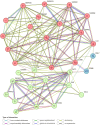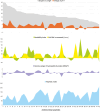Significance of host antimicrobial peptides in the pathogenesis and treatment of acne vulgaris
- PMID: 39744637
- PMCID: PMC11688235
- DOI: 10.3389/fimmu.2024.1502242
Significance of host antimicrobial peptides in the pathogenesis and treatment of acne vulgaris
Abstract
Acne vulgaris (AV) is a chronic inflammatory condition of the pilosebaceous units characterized by multiple immunologic, metabolic, hormonal, genetic, psycho-emotional dysfunctions, and skin microbiota dysbiosis. The latter is manifested by a decreased population (phylotypes, i.e., genetically distinct bacterial subgroups that play different roles in skin health and disease) diversity of the predominant skin bacterial commensal - Cutinbacterium acnes. Like in other dysbiotic disorders, an elevated expression of endogenous antimicrobial peptides (AMPs) is a hallmark of AV. AMPs, such as human β-defensins, cathelicidin LL-37, dermcidin, or RNase-7, due to their antibacterial and immunomodulatory properties, function as the first line of defense and coordinate the host-microbiota interactions. Therefore, AMPs are potential candidates for pharmaceutical prophylaxis or treating this condition. This study outlines the current knowledge regarding the importance of AMPs in AV pathomechanism in light of recent transcriptomic studies. In particular, their role in improving the tight junctions (TJs) skin barrier by activating the fundamental cellular proteins, such as PI3K, GSK-3, aPKC, and Rac1, is discussed. We hypothesized that the increased expression of AMPs and their patterns in AV act as a compensatory mechanism to protect the skin with an impaired permeability barrier. Therefore, AMPs could be key determinants in regulating AV development and progression, linking acne-associated immune responses and metabolic factors, like insulin/IGF-1 and PI3K/Akt/mTOR/FoxO1 signaling pathways or glucotoxicity. Research and development of anti-acne AMPs are also addressed.
Keywords: Cutibacterium acnes; acne vulgaris; antimicrobial peptides; inflammation; skin dysbiosis.
Copyright © 2024 Lesiak, Paprocka, Wnorowska, Mańkowska, Król, Głuszek, Piktel, Spałek, Okła, Fiedoruk, Durnaś and Bucki.
Conflict of interest statement
The authors declare that the research was conducted in the absence of any commercial or financial relationships that could be construed as a potential conflict of interest. The author(s) declared that they were an editorial board member of Frontiers, at the time of submission. This had no impact on the peer review process and the final decision.
Figures








References
Publication types
MeSH terms
Substances
LinkOut - more resources
Full Text Sources
Medical
Molecular Biology Databases
Research Materials
Miscellaneous

